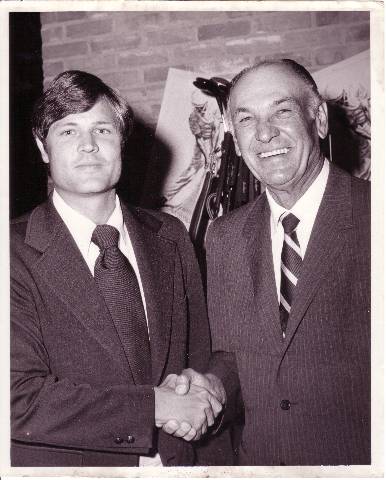By Mike May
As we look forward to this year’s major championships in men’s golf, one of the great champions from the past who is often honored with words of praise and admiration is the late, great Ben Hogan. In his hall-of-fame career, Hogan won two Masters, four U.S. Opens, one (British) Open Championship, and a pair of PGA Championships. In fact, this year (2023) is the 70th anniversary of when Hogan won three of the four majors in one year. In 1953, Hogan captured the Masters, U.S. Open (at the Oakmont Country Club in Pennsylvania), and the Open Championship (at Carnoustie in Scotland). What’s interesting about Hogan winning the Triple Crown of Golf in 1953 is that he had no chance of winning golf’s Grand Slam that year since the 1953 PGA Championship (July 1-7) overlapped with the playing of that year’s (British) Open Championship (July 6-10). It’s also worth noting that Hogan only played in the (British) Open Championship on one occasion – that being 1953, and he won it! No other golfer won three majors in one calendar year until Tiger Woods did it in 2000.
While the vast majority of people who have read about Hogan or even saw him play actually never met him, but Royal Palm Beach, Florida resident Chuck Ludwig, currently the sales & service representative in southeast Florida for Nexbelt, did meet Hogan on 15 occasions. The venue was the annual sales conference for the Ben Hogan Company, for whom Ludwig was a sales rep at the time.
When asked if Hogan would ever talk fondly of his competitive days on the PGA Tour, he, unfortunately, did not say too much.

“His role during our national sales meetings (for the Ben Hogan Company) was to introduce the new equipment line and pump us up to go out and sell to the PGA golf professional customers,” said Ludwig.
When asked if Hogan ever said much about his peers such as Sam Snead, Byron Nelson and Jimmy Demaret, he would say very little, but he was quick to identify South African Bobby Locke as the best pro at match play. And, Hogan said that Bobby Jones was probably the most gifted and talented player in golf.
“He (Hogan) did say that Bobby Locke was the best player he played one on one,” added Ludwig. “He did say “if you want to know how good Booby Jones was, try hitting golf clubs with wooden shafts.”
As for how involved Ben Hogan was with the design of the clubs bearing his name, he was “100%” involved with the company’s final product decisions, according to Ludwig.
Another interesting fact about Hogan’s career centers around his U.S. Open victories. Officially, he has four U.S. Open wins – in 1948, 1950, 1951, and 1953. But, back in 1942, when the USGA did not officially host the U.S. Open, Hogan won the Hale America National Open Golf Tournament.
Because of the Japanese attack on Pearl Harbor in December 1941, the USGA’s executive committee felt it was inappropriate to stage the U.S. Open in 1942. So, the USGA, in cooperation with the PGA of America and the Chicago District Golf Association, hosted a war-time substitute for the U.S. Open, which was called the Hale America Open. It was held at the Ridgemoor Country Club in Cook County, Illinois from June 18-21, 1942. For his win, Hogan received a USGA gold medal and $1,200 in war bonds.
The inscription on that 1942 gold medal was the same as it appears on his four official U.S. Open wins, but on the flip side of his 1942 medal, it had different wording: “The Hale America National U.S. Open Championship.”
“At some of our national sales meetings, Mr. Hogan would show the sales reps a small box which included five U.S. Open winner medals,” said Ludwig. “They were all the same, except one in 1942. He felt that he won five U.S. Open Championships.”

There are some golf historians and supporters of Hogan who feel that Hogan should be given credit for five U.S. Open wins since it was conducted just like other U.S. Opens with more than 1,500 entries, local qualifying at 69 sites and sectional qualifying at most major cities. In addition, all of the big names in golf, who were not fighting in WWII, were in the field. To boost local fan interest in the last round, Hogan, who was tied for the lead after three rounds, was paired with the legendary Bobby Jones, who played in the event and was not in contention.
Ludwig also remembers Hogan always played with a U.S. Open-mindset.
“He told us he felt like every golf tournament he played in was the U.S. Open,” said Ludwig.
As talented a golfer as he was, one of Hogan’s finest traits was his ability to respect and honor others, especially PGA teaching pros.
“What a gentleman he was and the respect he had for the PGA golf professional,” concluded Ludwig.

